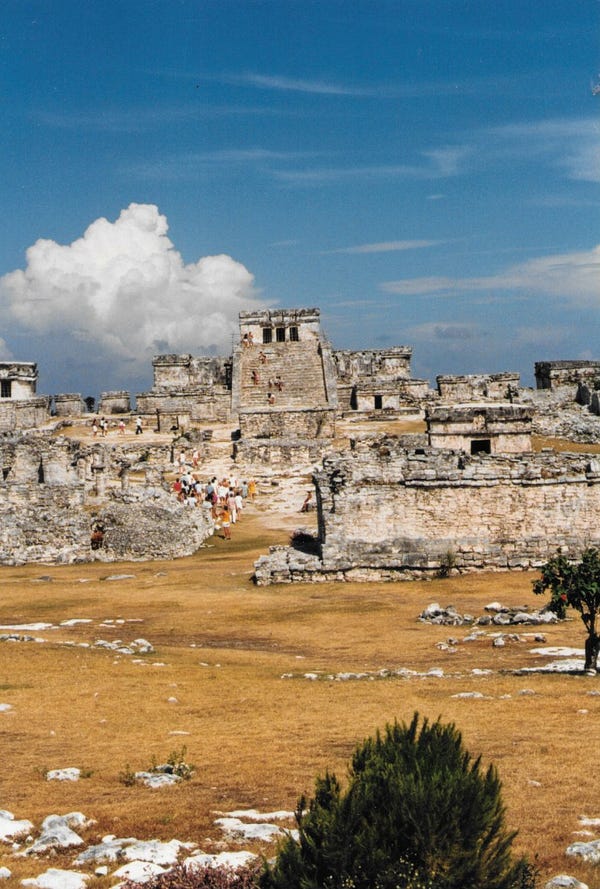Today’s Contemplation: Collapse Cometh LXVII
(originally posted September 16, 2022)

Those Dangerous Complexities of Human ‘Progress’
Today’s contemplation is a short reflection (and reiteration) on where I believe human ‘energies’ should be focused as we stumble into an unknowable future in light of an article on the topic that was shared to one of the Facebook groups I am a member of via a compilation of related articles periodically distributed by The Collapse Chronicle…
‘Peak humanity’ would appear to have been a direct result of our leveraging of a one-time cache of ancient carbon energy that has afforded us the ability to expand our numbers and environmental impact for quite some time but has, unfortunately, placed us firmly into ecological overshoot — a significant growth far beyond our environment’s ability to support on a continuing basis our numbers and material demands.
Virtually every species that enters such a predicament experiences the ‘collapse’ that inevitably follows once the fundamental resource that has allowed it to blast past its natural carrying capacity is ‘exhausted’ (in the case of fossil fuels, it’s about a declining energy-return-on-energy-invested and the hyper-exploitation of the resource — and others, as well as an overloading of natural sinks — via debt/credit expansion to reduce significantly its future availability).
This impending ‘collapse’ is problematic on a number of fronts but I would contend that it is particularly so because of some very dangerous complexities we have created and distributed around our planet, placing our long-term future and that of many other (all?) species in great peril.
Energy is ‘everything’ to life and the surplus energy we garnered from our exploitation of fossil fuels has led to our hyper-complex and globalised industrial society. Along the way the vast majority of humans have lost the knowledge and skills to be self-sufficient and adapt to a life without fossil fuel energy and its long list of ‘conveniences’. Of particular note should be our dependence upon long-distance supply chains for virtually all our most important needs: food, potable water, and regional shelter materials.
While relocalising these necessary aspects of our existence should be a priority for every community that wishes to weather the coming transition to a post-carbon world, we should be considering quite seriously the safe decommissioning of some significantly dangerous creations.
Three of the more problematic ones include: nuclear power plants and their waste products; chemical production and storage facilities; and, biosafety labs and their dangerous pathogens. The products and waste of these complex creations are not going to be ‘contained’ when the energy to do so is no longer available. And loss of this containment will create some hazardous conditions for human existence in their immediate surroundings at the very least — in fact, multiple nuclear facility meltdowns could potentially put the entire planet at risk for all species[1].
As of today’s date, some 438 nuclear reactors (with another 56 under construction) are spread throughout 32 nation-states[2].
Finding the actual number of chemical production and storage facilities that exist is next to impossible but a proxy of their existence can be imagined via their economics and global spread of the industry[3], and it is massive.
As for biosafety labs, the total number is also virtually impossible to nail down due to the various ‘levels’ assigned, but as for those ‘studying’ the most dangerous pathogens, currently 59 are spread around the globe[4].
These facilities, even with today’s high-energy inputs and safety protocols, have experienced catastrophic ‘accidents’ — at least for the immediate environment/ecological systems, residents of the area, and/or employees.
From Chernobyl and Fukushima[5], to Bhopal and Beirut[6], to numerous lab failures[7] and ‘accidental’ infections and deaths of lab employees[8] (to say little of the recent possibility of Covid-19 having escaped from a lab[9]), the dangers posed by them have periodically been quite obvious.
As our surplus energy to minimise these dangers falls, our ability to protect ourselves from them also declines increasing the risks that they pose substantially. It seems only prudent to decommission and ‘safely’ eliminate the dangers while we still have the energetic-ability and resources to do so.
There is little in our current thinking about this situation that leads me to believe we will address these potential catastrophes, however. In fact, I see significant hubris and denial on a daily basis as we surge headlong in the opposite direction expanding on these complexities for the most part rather than reducing them — to say little of our continuing pursuit of the infinite growth chalice on a finite planet.
The fact that we seem to be doing the exact opposite of what seems prudent and forward-thinking does not instill a lot of confidence in me for our long-term prospects. Our failure to address the potential lethal consequences — primarily, it would seem, because of our continuing belief that we can both predict and control complex systems, and because these pursuits further enrich the ruling elite — raises the stakes significantly for both current and future generations, as well as all other life on the planet.
[1] Here I am reminded of the television series The 100 where the fourth season is centred around the devastation wreaked by a wave of fire and radiation that sweeps across the planet as a result of several dozen of the globe’s nuclear plants melting down; their ongoing maintenance was impossible after a complex AI launches the world’s nuclear weapons arsenal in an effort to address human overpopulation. https://en.wikipedia.org/wiki/The_100_(TV_series)
[2] https://en.wikipedia.org/wiki/Nuclear_power_by_country
[3] https://en.wikipedia.org/wiki/List_of_largest_chemical_producers; https://en.wikipedia.org/wiki/Chemical_industry; https://www.yourarticlelibrary.com/industries/top-10-chemical-producing-countries-of-the-world/25394; https://chempedia.info/info/chemical_production_facilities/
[4] https://theconversation.com/fifty-nine-labs-around-world-handle-the-deadliest-pathogens-only-a-quarter-score-high-on-safety-161777;
[5] https://en.wikipedia.org/wiki/Nuclear_and_radiation_accidents_and_incidents
[6] https://en.wikipedia.org/wiki/Chemical_accident
[7] https://eu.usatoday.com/story/news/2016/06/02/newly-disclosed-cdc-lab-incidents-fuel-concerns-safety-transparency/84978860/; https://www.researchgate.net/publication/340402767_Laboratory_accidents_and_breaches_in_biosafety_-_they_do_occur
[8] https://www.torontomu.ca/content/dam/facilities-management-development/environmental-health-safety/docs/2-biological-hazard-classification.pdf
[9] https://www.bmj.com/content/374/bmj.n1656; https://theintercept.com/2022/05/06/deconstructed-lab-leak-covid-katherine-eban/